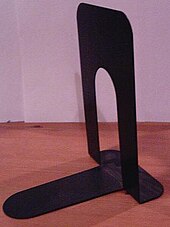


A bookend is an object tall, sturdy, and heavy enough that is placed at either end of a row of upright books to support or buttress them. Heavy bookends—made of wood, bronze, marble, and even large geodes—have been used in libraries, stores, and homes for centuries; the simple sheetmetal bookend (originally patented in 1877 by William Stebbins Barnard)[1] uses the weight of the books standing on its foot to clamp the bookend's tall brace against the last book's back; in libraries, simple metal brackets are often used to support the end of a row of books. Elaborate and decorative bookends are common as elements in home decor.
The word "bookend" is also used metaphorically to refer to any pair of items which frame and define a significant or noteworthy event or place. For example, regarding the practice in the United States whereby Memorial Day and Labor Day demarcate the traditional beginning and end of summer, those two holidays could be referred to as bookends. Bookends are usually made of metal and plastic.